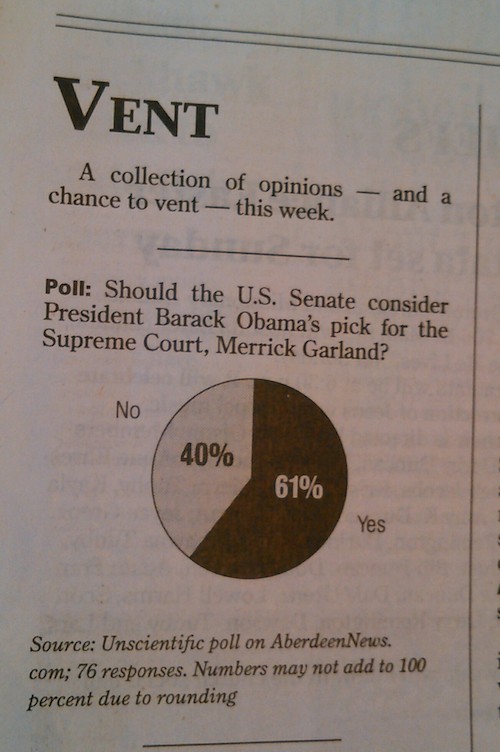In good news, the Aberdeen American News reports that a majority of my click-inclined neighbors agree that the Senate should do its job and at least consider Judge Merrick Garland, President Barack Obama’s nominee:

The bad news is that someone at the paper needs a better calculator. AAN comes up with percentages of 61% and 40% and says, “Numbers may not add to 100 percent due to rounding.” However:
- The integers closest to the above reported results are 46 and 30.
- 46 divided by 76 is 60.5263%, which properly rounded to two significant digits gives us 61%.
- 30 divided by 76 is 39.4737%, which properly rounded to two significant digits gives us 39%.
AAN appears to have committed the classic error of rounding before rounding. Often on my spreadsheets, I’ll have a column set to report percentages to just one decimal point. My computer will divide 30 by 76, get 39.4737%, then round and display 39.5%. If my calculations only have two significant digits, I might glance at the spreadsheet display and report 40% (technically, 40%). But that would be wrong: to properly round to the ones place, I need to look back to the unrounded tenths place and the hundredths place after it, to make sure that I’m not pulling a number that’s less than half up to the next integer.
The potential for this error haunted me in high school when Coach Jerome Garry introduced us to significant digits. The notion that incautious rounding or trust of machines could round a number as low as 49.44444445% up to 50% struck me as a grave mathematical injustice to be avoided at all costs. (Yes, I was that kind of math student. Still am.)
Rounding can indeed produce percentages that don’t add up to 100, but not on a binary poll with 76 respondents. The only binary poll results that can round to figures that sum to 101 are results that both fall on a point-5, like 60.5% to 39.5%, or, more tantalizingly, 50.5% to 49.5%. But note that exact results like that (not just 50.5%, but 50.500000000…% on the button) cannot occur until you have a sample size of 200, and after that only for sample sizes that are multiples of 200 (400, 600, 800, 1,000…). Otherwise, one percentage close to the rounding threshold will always be X.5 plus a teeny-tiny fraction, meaning the other percentage will necessarily be Y.5 minus that teeny-tiny fraction. X.5+ttf will round up to X+1, and Y.5–ttf will round down to Y, and X+Y will always equal 100.
Fortunately, none of this rounding is necessary to hold hearings and confirm Merrick Garland. We just need one nice integer, 51 Senators with the integrity to do their jobs.
Look at it on the bright side Cory, if you were a republican, you would just be making numbers up to suit your purpose. It’s much better to be a stickler for proper numbers!
Thanks, Tim! Funny—even though I left the Republican party over a decade ago, I still enjoy working with the square root of –1.
It is indeed funny we are blogging about proper numbers here. Recently it seems there have been many wrong numbers blogged.
Mitch McCTurtle is rilly mad at Obama. Obie chose a Kentucky Soopreme Ct justice for a vacancy on the 6th Court of Appeals and Mitchie says no hearings for this judge,either,because Obama didn’t consult with McCTurtle before the selection. What an absolute bawl baby poopy John.
Not to worry about splitting hairs while rounding on polls. There may be a 20% variance between real world and poll results anyway.
20%? Douglas, I say 40% for online polls… 50% if Grudz is allowed to vote.